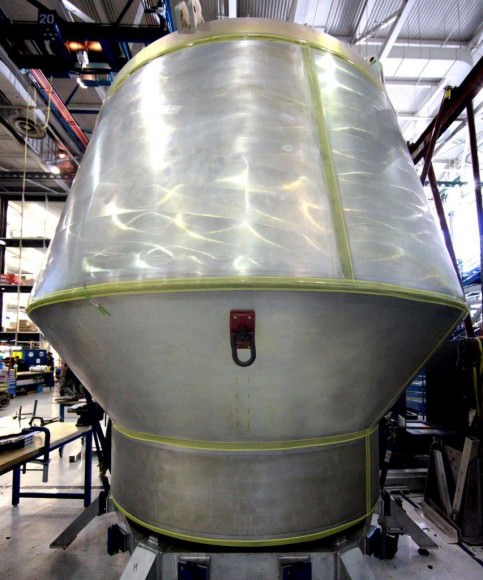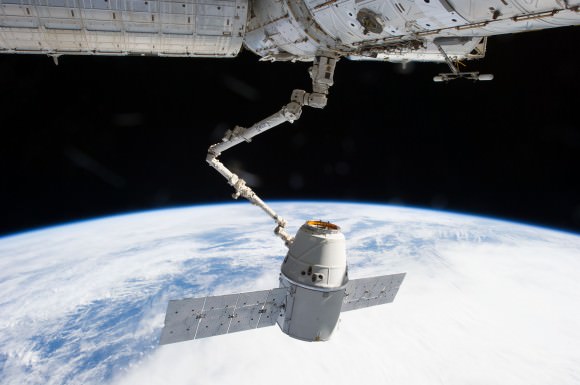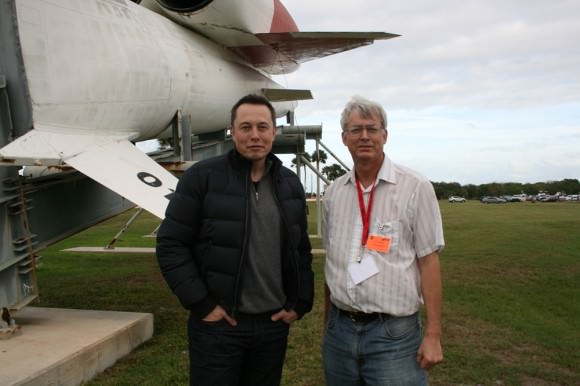Falcon 9 SpaceX CRS-2 launch of Dragon spacecraft on March 1, 2013 to the ISS from pad 40 at Cape Canaveral, Florida.- shot from the roof of the Vehicle Assembly Building. During 2014, SpaceX plans two flight tests simulating human crewed Dragon emergency abort scenarios launching from right here at pad 40. Credit: Ken Kremer/www.kenkremer.com
Story updated[/caption]
CAPE CANAVERAL AIR FORCE STATION, FL – A trio of American companies – SpaceX, Boeing, and Sierra Nevada – are working diligently to restore America’s capability to launch humans into low Earth orbit from US soil, aided by seed money from NASA’s Commercial Crew Program in a public-private partnership.
We’ve been following the solid progress made by all three companies. Here we’ll focus on two crucial test flights planned by SpaceX in 2014 to human rate and launch the crewed version of their entry into the commercial crew ‘space taxi’ sweepstakes, namely the Dragon spacecraft.
Recently I had the opportunity to speak about the upcoming test flights with the head of SpaceX, Elon Musk.
So I asked Musk, the founder and CEO of SpaceX, about “what’s ahead in 2014”; specifically related to a pair of critical “abort tests” that he hopes to conduct with the human rated “version of our Dragon spacecraft.”
“Assuming all goes well, we expect to conduct [up to] two Dragon abort tests next year in 2014,” Musk told me.

The two abort flight tests in 2014 involve demonstrating the ability of the Dragon spacecraft abort system to lift an uncrewed spacecraft clear of a simulated launch emergency.
The crewed Dragon – also known as DragonRider – will be capable of lofting up to seven astronauts to the ISS and remaining docked for at least 180 days.
First a brief overview of the goals of NASA’s Commercial Crew Program. It was started in the wake of the retirement of NASA’s Space Shuttle program which flew its final human crews to the International Space Station (ISS) in mid-2011.
“NASA has tasked SpaceX, Boeing, and Sierra Nevada to develop spacecraft capable of safely transporting humans to the space station, returning that capability to the United States where it belongs,’ says NASA Administrator Charles Bolden.
Since 2011, US astronauts have been 100% dependent on the Russians and their Soyuz capsules to hitch a ride to low Earth orbit and the ISS.
The abort tests are essential for demonstrating that the Dragon vehicle will activate thrusters and separate in a split second from a potentially deadly exploding rocket fireball to save astronauts lives in the event of a real life emergency – either directly on the launch pad or in flight.
“We are aiming to do at least the pad abort test next year [in 2014] with version 2 of our Dragon spacecraft that would carry astronauts,” Musk told me.

SpaceX plans to launch the crewed Dragon atop the human rated version of their own developed Falcon 9 next generation rocket, which is also being simultaneously developed to achieve all of NASA’s human rating requirements.
The initial pad abort test will test the ability of the full-size Dragon to safely push away and escape in case of a failure of its Falcon 9 booster rocket in the moments around launch, right at the launch pad.
“The purpose of the pad abort test is to demonstrate Dragon has enough total impulse (thrust) to safely abort,” SpaceX spokeswoman Emily Shanklin informed me.
For that test, Dragon will use its pusher escape abort thrusters to lift the Dragon safely away from the failing rocket. The vehicle will be positioned on a structural facsimile of the Dragon trunk in which the actual Falcon 9/Dragon interfaces will be represented by mockups.
This test will be conducted on SpaceX’s launch pad 40 at Cape Canaveral Air Force Station in Florida. It will not include an actual Falcon 9 booster.
The second Dragon flight test involves simulating an in flight emergency abort scenario during ascent at high altitude at maximum aerodynamic pressure at about T plus 1 minute, to save astronauts lives. The pusher abort thrusters would propel the capsule and crew safely away from a failing Falcon 9 booster for a parachute assisted landing into the Atlantic Ocean.
“Assuming all goes well we expect to launch the high altitude abort test towards the end of next year,” Musk explained.
The second test will use the upgraded next generation version of the Falcon 9 that was successfully launched just weeks ago on its maiden mission from Cape Canaveral on Dec. 3. Read my earlier reports – starting here.

To date, SpaceX has already successfully launched the original cargo version of the Dragon a total of three times. And each one docked as planned at the ISS.
The last cargo Dragon blasted off on March 1, 2013. Read my prior articles starting – here.
The next cargo Dragon bound for the ISS is due to lift off on Feb. 22, 2014 from Cape Canaveral, FL.

Orbital Sciences – the commercial ISS cargo competitor to SpaceX – plans to launch its Cygnus cargo vehicle on the Orb-1 mission bound for the ISS on Jan. 7 atop the firms Antares rocket from NASA Wallops Flight Facility in Virginia. Watch for my on site reports from NASA Wallops.
NASA’s Commercial Crew Program’s goal is launching American astronauts from U.S. soil within the next four years – by 2017 to the ISS.
The 2017 launch date is dependent on funding from the US federal government that will enable each of the firms to accomplish a specified series of milestones. NASA payments are only made after each companies milestones are successfully achieved.
SpaceX was awarded $440 million in the third round of funding in the Commercial Crew integrated Capability (CCiCAP) initiative which runs through the third quarter of 2014. As of November 2013, NASA said SpaceX had accomplished 9 of 15 milestones and was on track to complete all on time.
Musk hopes to launch an initial Dragon orbital test flight with a human crew of SpaceX test pilots perhaps as early as sometime in 2015 – if funding and all else goes well.
Either a US commercial ‘space taxi’ or the Orion exploration capsule could have blasted off with American astronauts much sooner – if not for the continuing year-by-year slashes to NASA’s overall budget forced by the so called ‘political leaders’ of all parties in Washington, DC.

Stay tuned here for Ken’s continuing SpaceX, Orbital Sciences, commercial space, Chang’e-3, LADEE, Mars and more news.
…………….
Learn more about SpaceX, Orbital Sciences Antares Jan. 7 launch, Curiosity, Orion, MAVEN, MOM, Mars rovers and more at Ken’s upcoming presentations
Jan 6-8: “Antares/Cygnus ISS Rocket Launch from Virginia on Jan. 7”; Rodeway Inn, Chincoteague, VA, evening



I for one, certainly don’t mind waiting for further tests of the ‘Grasshopper’ launch return version of the Falcon or the Falcon Heavy if it means getting crew to orbit in the Dragon manned rated capsule first! Can’t wait for that! GO Space-X! GO USA!
Q: Is Elan planning to go up to the ISS in one of his Dragon’s? Am sure the welcome mat would be out.. I’d go if I were him, just because I could!
Minor oopsey: “Watch for my o site reports..”
They are done with the Grasshopper, as far as I know. The next tests will be with falcon9R prototypes from the Mohave spaceport. How cool is that 🙂
Not Mojave, but rather the New Mexico Spaceport over by White Sands. And though it will essentially be a Falcon Niner, some people (including some in SpaceX) insist on calling it the Grasshopper 2…
Why White Sands rather than Mojave? More empty space so they don’t have to worry about hitting any airliners going up, and just in case they wind up making a crater or two coming down…
My bad 🙁 wasen’t 100% sure. should have doublechecked..
well well.. Grasshopper 2? I can understand why they want to keep that Grasshopper name. “Grasshopper 2” sounds better in the press rather than “Falcon 9R” if one of those craters should come to be. They want to keep the Falcon name clean. The tabloid press will never see the difference from the workhorse Falcon 91.1 and Falcon 9R prototype.
That’s not a bad point. PR is a powerful force.
It will be a modified Falcon 9V1.1 first stage, without the interstage or the second stage, as far as I know. It’s not a full Falcon 9R rocket – or even a first stage – because that rocket doesn’t exist yet;).
The tests with the modified V1.1 first stage will help SpaceX refine the design of the stage after each test (and before the next). Over time, as they gain experience, they will slowly converge on a new first stage design. That will be the Falcon 9R.
gopher
AFAIK vehicle tested in NM is for all intents and purposes a production equivalent Falcon 9R… body, engines, legs, avionics… that’s the point..
It is basically the same first stage as will fly and attempt to be recovered on the Feb CRS-3 flight…which will have legs
The F9 1.1 was designed for reusability, with structure for legs, a Reaction Control System, extra insulation, etc….
The NM tests are to validate the legs and software as possible before the CRS3 flight..
However, there is no downside to trying to recover the CRS3 first stage regardless of the GH V1.1 tests, as otherwise the stage is lost anyway…
I thought falcon was designed to be human rated at the beginning. That being said trying to recover will be dicey, the more parts you take up in initial launch the more that can fail. It’s why they are not trying it in the geo launches, also you have to keep a fair amount of fuel onboard for the trip down.
Please note that I wrote… “…tests of the ‘Grasshopper launch return _version of the Falcon or the Falcon heavy_..”
We need a manned US spaceship to launch ASAP! no more delays
1st crew will be test pilots. after that – we’ll see
typos fixed – story updated
Amen.
And by ‘delays’ I’d hope that includes Congress desisting from cutting the Administration’s Commercial Crew budget request from $850 million for Crewed Dragon, CST-100 and Dream Chaser down to $450 so Congress can divert more of NASA’s $$$ to that corporate welfare and pork fountain, the SLS.
would like to see him with a wig and false mustage and that people don’t recognize Elon and when they are on the station I would like to see him there removing those apparels showing himself saying Hi here I am surprise !! I would show one heck of trust in his own product from a sales prospective
Musk has a crazy brain on him. He seems to do it all – from space to cars, the hyperloop (which I’m not sure will materialize, but I wouldn’t bet against him), to music on MusicUnited.com, and his past at PayPal. Amazing guy!
“on Jan. 7 atop the firms Antares rocket…”
firm’s
“NASA payments are only made after each companies
milestones are successfully achieved.”
company’s
Does anyone proofread these articles?
The most interest fact here is Musk says we could have a manned test flight for the Falcon 9 next year(!)
Bob Clark
I believe this is nothing new. Musk has been stating for quite some time that they’re aiming for a 3-day LEO flight with an internal crew in 2015.